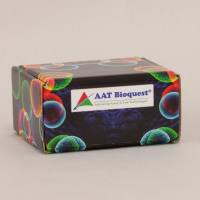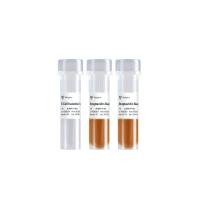neuromelanin isolation and identification
互联网
These instructions relate in detail how we prepare neuromelanin (NM) from PC12 cells and the conditions used for electron paramagnetic resonance (EPR) detection of NM. Please see the accompanying article:
Sulzer, D., Bogulavsky, J., Larsen, K.E., Karatekin, E., Kleinman, M., Turro, N., Kranz, D., Edwards, R., Greene, L.A., Zecca, L. (2000) Neuromelanin synthesis sequesters cytosolic catecholamines not accumulated by synaptic vesicles. Proc Natl Acad Sci USA, in press.
Isolation and purification of NM
For preparation for electron paramagnetic resonance (EPR), cells maintained in each condition were scraped in phosphate buffered saline, pH 7.4, and centrifuged at 900 rpm for 2 min at 37o C. The supernatant was removed, the pellet washed in phosphate buffer, centrifuged at 10,000 G for 15 min at RT, and resuspended. This was repeated twice. The pellet was then resuspended in 0.1 N PBS for a final volume of 150 µl, frozen in liquid N2 and stored on dry ice.
For purification of NM from cells, frozen cells (typically 3 x 108) were thawed at RT , washed in 10 ml of 0.05 N phosphate buffer pH 7.2, centrifuged at 10,000 G for 15 min at RT , washed, and recentrifuged. Samples received 10 ml of 5 mg/ml SDS in 75 mM Tris, pH 7.5, were sonicated, and incubated for 3 h at 37o C in a shaking water bath. The preparations were centrifuged at 10,000 G at RT for 30 min and the supernatant removed. Two ml of 5 mg/ml SDS in 75 mM Tris, pH 7.5 with 0.33 mg/ml proteinase K (Sigma) was added to the pellet and incubated for 3 h at 37o C. The samples were centrifuged at 10,000 G at RT for 30 min and the supernatant removed. The pellets were washed with 3 ml 0.9% NaCl and centrifuged at 10,000 G at RT, the supernatant discarded, and the pellet transferred to corex tubes. The pellet was rewashed in 3 ml of water, and centrifuged at 10,000 G at RT for 30 min and the supernatant removed. The pellet was rewashed in 3 ml of methanol followed by 3 ml of hexane and centrifuged at 10,000 G at RT for 30 minutes. Isolated NM was dried under N2 gas and stored at -80oC.
Removal of bound metals from isolated NM
Isolated NM prepared was incubated in 3 ml of 150 mM EDTA-Na2 freshly bubbled with N2 gas for 24 h at RT . The EDTA solution was removed and the sample washed in 3 ml of water and centrifuged at 10,000 G at RT for 30 minutes. The water was removed by evaporating centrifuge or adding methanol and N2 gas.
EPR recordings
EPR Samples were resuspended in 150 µl of 0.1 N phosphate buffer, pH 7.3 for 24 h. Samples (4 mm diameter, 6-8 mm length) were placed directly into a finger dewar made of suprasil quartz (Wilmad Glas Co., Buena, NJ) and filled with liquid N2. Measurements used a Bruker ESP380E and Bruker EMX EPR spectrometer (Bruker Instruments Inc., Billerica, MA) operating at 9-10 GHz. Spectra were taken using a Bruker TE102 mode cavity and 100 KHz modulation amplitude using software supplied with the instrument. Spectra were taken at 77 K. The resonant frequency of the TE102 cavity was approximately 9.57 GHz with the ESP 380 E and 9.49 GHz with the EMX when loaded with the dewar and the sample. Two settings were used to detect (i) organic free radicals of NM (with g ~2) and (ii) additional signals from paramagnetic metal ions (g~4). For (i) settings were: scan range from 3210 to 3510 Gauss, time constant = 40.96 msec, conversion time = 40.96 msec, modulation amplitude = 3 Gauss, receiver gain = 105, microwave power = 5 mw. For (ii) a wider scan range (1000 to 4000 Gauss) and a higher modulation amplitude (8 Gauss) were employed. With these parameters, the time to sweep the spectra was 42 sec, for both (i) and (ii). Typically 20 to 40 sweeps were accumulated per spectrum. Signals were corrected for baseline drift, normalized for number of cells in the samples, and background in PBS subtracted. Employing different power levels, we found that at 5 mw the signals from the organic free radicals were optimized. EPR data was expressed as the first derivative of the absorption related to the increase in applied magnetic field. Comparisons of relative signal intensities were made by comparing peak heights.






